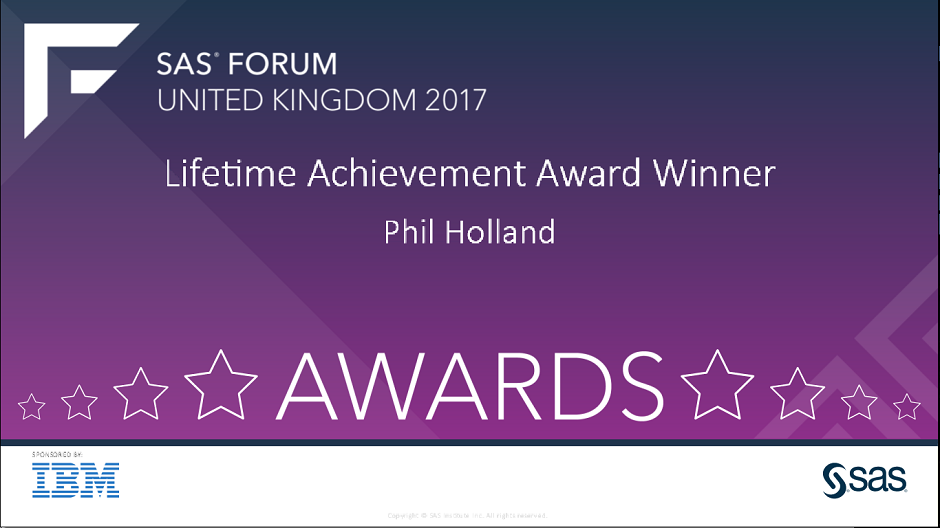![]()
Are you interested in SAS macros or SAS programming efficiency? I’ve updated my Android apps focusing on both these topics in Google Play and Amazon Appstore.
![]()
Are you interested in SAS macros or SAS programming efficiency? I’ve updated my Android apps focusing on both these topics in Google Play and Amazon Appstore.
![]()
ODS Graphics has been around since SAS 9.1.3 (in 2006!), and yet it hasn’t yet taken over the SAS graphics world, even though it could create the vast majority of graphs.
With this in mind I thought I’d create a quick poll to see what is currently being used out there in the real world:
[poll id=’3′]
If you think your company ought to be using ODS Graphics more, then download our SAS training course list for free.
If you would like to learn about ODS Graphics yourself, even if your company doesn’t want to pay for a training course for you and your colleagues, then you should read “Part III: Data Visualization” (chapters 9-14) in my book “SAS Programming and Data Visualization Techniques: A Power User’s Guide” instead.
![]()
The PhUSE Belgium SDE is being held at Janssen Pharmaceutica near Beerse again on Tuesday 28th November 2017, where I’ll be presenting “The Art of Defensive Programming – Coping with Unseen Data” at 1600hr.
I hoping to be able to run a free prize draw there for you to win a copy of my recent book “SAS Programming and Data Visualization Techniques: A Power User’s Guide“. Just drop in a business card or fill out a blank card at the event to get a chance to win a copy.
I’m looking forward to revisiting the site where I worked on my very first SAS contract in 1992, and maybe tasting some interesting Belgian beers too!
Hope to see you there.
![]()
SAS Global Forum is being held in Denver in 2018 from Sunday 8th to Wednesday 11th April, and I’ve been invited to present “The Art of Defensive Programming: Coping with Unseen Data” there.
I’m also hoping to run another prize draw again for you to win a copy of my latest book “SAS Programming and Data Visualization Techniques: A Power User’s Guide“. Just drop in a business card or fill out a blank card at the ODS Graphics stand to get a chance to win a copy.
Note, however, that at SASGF18 you will only be able to read a copy of the book contents at the stand, as during SASGF17 someone took away my well-used sample copy. So, if you still want to browse the sample, then you’ll have to find me among the expected 5,000+ attendees! 🙁
Hope to see you there.
![]()
This year the PhUSE Conference was held at the Edinburgh International Conference Centre, and in Scotland for the first time. This was my 13th PhUSE Conference, and I’d presented papers at all 13, which was more than anyone else! There were 695 attendees and 40 exhibitors at this PhUSE conference, more than at any previous PhUSE conference too!
I presented “Making Graphs Easier to Validate – The Benefits of ODS Graphics” in the Data Visualisation stream on the 1st afternoon, and the room was nearly full, which I found to be true for most of the other papers I attended during the rest of the conference too. It is always good to present to a full room, because you are more likely to get an audience response to what you are trying to explain.
CK Clinical had one of the exhibitors stands and ran a Connect4 knock-out competition over the 3 days, with the champion Kriss Harris winning Afternoon Tea for two at the Ritz (or equivalent), and runner-up Gareth Parry (see photo on right) winning a copy of my latest book “SAS Programming and Data Visualisation Techniques“.
and ran a Connect4 knock-out competition over the 3 days, with the champion Kriss Harris winning Afternoon Tea for two at the Ritz (or equivalent), and runner-up Gareth Parry (see photo on right) winning a copy of my latest book “SAS Programming and Data Visualisation Techniques“.
In 2018 the European PhUSE Conference will be held in Frankfurt, the 3rd time in Germany, but in November, rather than the traditional October, because a new US PhUSE Conference will be taking place in Raleigh NC in June.
![]()
There is now a new Training Course list for 2017Q4, which can be downloaded from here. The courses available in 2016 and early 2017 are still there, but had added a new course to the list:
I’m also developing some new SAS-related courses, based on the SAS course, which you can accelerate to production status by requesting them:
Your interest in any of these courses will result in them being developed as priority tasks!
![]()
PhUSE is being held in the Edinburgh International Conference Centre (EICC) in Edinburgh this year from Sunday 8th to Wednesday 11th October 2017, and I’ll be presenting “Making Graphs Easier to Validate – The Benefits of ODS Graphics” in the Data Visualization stream on the Monday afternoon at 1500hr.
PhUSE is now a global conference for the pharmaceutical software community, and there will be 600+ attendees in the following streams:
– Analytics & Statistics
– Application Development
– Coding Tips & Tricks
– Data Standards & Governance
– Data Handling
– Data Visualisation
– Industry Starters
– Management
– Professional Development & Training
– Posters
– Regulatory
– Real-world Evidence
– Software Demonstrations
– Standards Implementation
– Trends & Technology
– Hands-on Workshops
– University Day
CK Clinical will be running a competition (I think it will be Connect4), and one of the prizes will be a copy of my recent book “SAS Programming and Data Visualization Techniques: A Power User’s Guide”. Visit Stand 37 in the Exhibitors Area to get a chance to win a copy.
I’m also planning my annual beer-tasting evening on the Tuesday during the conference at a local venue. Unfortunately attendance will be limited to the first 20 attendees to confirm interest with me at the conference itself, so talk to me early if you’d like to attend!
Hope to see you there.
![]()

My university degrees were in Chemistry, but when I tried to find my first job there were none in Chemistry, so, as I’d developed an interest in computing, I decided to move into Information Technology instead. I have never really considered my jobs to be work, even to the present day, but more like a paid hobby.
I first encountered SAS software (version 79.5) in 1981 while working as a mainframe systems programmer at the University of London Computer Centre. Not long after that I was the SAS Representative at Prudential Assurance in London installing SAS on their mainframes, and making myself known to SAS UK by asking their Technical Support question after question about a wide range of SAS features.
In September 1992, 25 years ago, I went freelance, formed my own SAS software consultancy, Holland Numerics Limited, and started work on the first of two SAS contracts in Belgium. Since then I have also worked with, and provided training for, SAS-using companies in the UK, Netherlands, Germany, France, Switzerland, Spain and the USA. As a permanent employee I was never allowed to attend conferences, so I’ve made the most of my freelance status to attend at least one conference every year since 1993, and have presented SAS-related papers at many international conferences since 1995 too. My first paper was presented at SeUGI in Stockholm.
I discovered social media in 2005 when I registered on LinkedIn, but my social media activities really took off in 2008 when I joined Squidoo, and then Twitter, to advertise my first SAS-related book, “Saving Time and Money Using SAS” published by SAS Press. Since then I’ve become active on a number of sites answering SAS-related questions and advertising more of my books. The web sites have included LinkedIn Groups, SASProfessionals.Net, sasCommunity.org, Google+ Communities, SAS Customer Support Communities, BeBee, and now WordPress on this site.

So why do I still not believe that I’ve won a SAS award? I was sent an email the previous week asking if I wanted to attend the Awards Dinner at SAS Forum UK, as I’d been nominated for an award, but not that I’d actually won one, or even which award it was. Everyone from SAS UK I’d met from when I arrived at the conference in Birmingham had been very welcoming, but that certainly wasn’t unusual. Even the description of me before my name was finally revealed referred to me presenting on Analytics at conferences didn’t seem to fit either (until someone later explained to me that SAS staff generally include graphics in Analytics!). Even stepping onto the stage to receive my award felt like I was part of an elaborate hoax, but the warmth of Laurie Miles and Charles Senabulya soon removed that thought from my mind, and I felt extremely honoured to be there and receiving the SAS Lifetime Achievement Award from friends I admired.
Back at my seat I sent a message to my wife Angela to tell her about it. She replied: “Does that mean you can retire as they don’t expect you to do anything else”. Remember at the top of this post I called my job a paid hobby. Some people retire so they’ll have more time to spend on their hobbies, but I’m not sure it is possible to retire from a hobby!!
![]()

Congratulations to Peter Lowes from BusinessData Partners, who won a copy of my latest book, “SAS Programming and Data Visualization Techniques”. Thank you also to all the SAS Forum UK 2017 attendees who entered the book prize draw, but didn’t win this time. I hope you will try again at another conference where I’ll be holding a book prize draw in the future.
![]()
SAS Forum UK 2017 is being held in the Vox Conference Centre near the Birmingham NEC again this year from Tuesday 26th to Wednesday 27th September 2017, and I’ll be presenting “Making Graphs Easier to Validate – The Benefits of ODS Graphics” at 1130hr in the Tech Tips stream on the Tuesday.
It will not a very big conference (although last year there were 650 attendees spread over the 2 days), as not everyone attends both days, but it will lean heavily towards techie topics again. Those looking to take certification exams will be able to do so during Tuesday, Tuesday also includes streams for “Expert services for: Learning & Academia”, “Expert services for: Consulting & Premium Support”, “Tech Tips” and “Super Demos”, and the Wednesday will include streams for “Customer Stories”, “SAS Presents”, “Technical Insights” and more “Super Demos”. See the SAS Forum UK 2017 web site for more details.
I will be running a prize draw again for you to win a copy of my recent book “SAS Programming and Data Visualization Techniques: A Power User’s Guide”. Just drop in a business card or fill out a blank card at the stand to get a chance to win a copy.
Hope to see you there.
![]()
The Winter 2011 issue of VIEWS News was the last issue published back in January 2012, but would you like me to publish a brand new issue 56 soon?
Currently there are only 10 subscribers to VIEWS UK, and I would really like to see more. If you would like me to publish a brand new issue 56, then I would need to have at least 100 subscribers before I start work on it. There is no point in me starting work on the new issue unless there are enough expected readers of the new publication.
Please follow the instructions in my recent blog post if you would like to subscribe to VIEWS UK.
![]()
Recently I reported that the VIEWS web site had been closed down, but that the newsletter archive was still available on sasCommunity.org. I have now been able to store the original VIEWS News PDF files on my blog site, which can be accessed via a new VIEWS UK forum. This forum is available on request to all registered blog members, and those with access will be notified of any new content.
Some of the new content will include previously unpublished indexes I used to help me write the Formats, Options & Functions articles in the newsletters, which allowed me to see in a single view which features had already been described and when. I will also be including an authors list soon. All features that could help you find information that is difficult to find using standard searches. I may even try to publish some new issues of VIEWS News soon too!
You might be thinking that, as I had emailed VIEWS members in the past, I could use that email list to include them automatically again. However, this new VIEWS environment has been built on an existing blog site, and, although theoretically I could register all the previous VIEWS members using their email addresses, I don’t know all of their real names and would, therefore, have to guess their new user names, so I don’t think forcing anyone to register on my blog site is at all appropriate. This is the reason I’m asking everyone interested to register themselves instead.
SO, whether you have been a VIEWS member in the past, or not, here is how you can join the new VIEWS UK forum:
You must be logged in to post a comment.